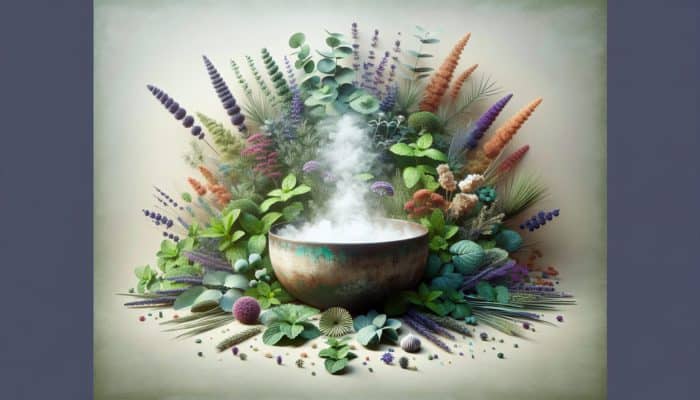Maximise Your Health with Effective Herbal Steam Inhalation Techniques
The growing popularity of herbal steam inhalation reflects a rising interest in holistic wellness, especially amidst the challenges of modern life characterised by stress and various health issues. This practice utilises the remarkable healing properties of an array of herbs, combined with the comforting effects of steam, offering a wide array of health benefits. Its therapeutic advantages reach far beyond simple relaxation, encompassing crucial aspects of respiratory health, skin rejuvenation, and mental well-being, making it an integral part of any thorough wellness routine.
Enhance Your Respiratory Health with Herbal Steam Inhalation

The advantages of herbal steam inhalation techniques are particularly prominent when focusing on improving respiratory health. Inhaling steam that is infused with specific herbs can effectively clear nasal passages, making it a vital practice for individuals suffering from colds, allergies, asthma, and other respiratory challenges. The warmth of the steam acts as a natural decongestant, which assists in loosening mucus and phlegm that can hinder airflow, thereby promoting easier and more comfortable breathing.
In the UK, where seasonal allergies and respiratory issues are common, including herbs such as Eucalyptus or thyme in your steam inhalation routine can offer significant relief. Eucalyptus is particularly esteemed for its decongestant properties, providing comfort in the nasal passages, while thyme brings antiseptic benefits that may help combat infections. Recent research has underscored the effectiveness of steam inhalation for delivering both immediate relief and long-term improvements in respiratory function, notably reducing inflammation and enhancing lung capacity.
Regular practice of this inhalation technique not only relieves discomfort but also contributes to strengthening overall lung function. By integrating herbal elements into steam inhalation, users can experience a more profound therapeutic effect, making it a natural alternative to many conventional over-the-counter medications. For residents of urban areas such as London, where air quality issues exacerbate respiratory problems, adopting herbal steam inhalation into one’s daily health regimen presents a practical and beneficial health practice that can be easily implemented at home.
Transform Your Skin Health with Herbal Steam Inhalation
The skin, acknowledged as the body’s largest organ, reaps substantial benefits from the practice of herbal steam inhalation techniques. The heat generated by the steam effectively opens the pores, facilitating the elimination of impurities and toxins, which aids in achieving clearer and healthier skin. This technique is particularly advantageous for individuals dealing with skin conditions such as acne, eczema, or psoriasis.
Integrating herbs like lavender or chamomile during steam inhalation can significantly enhance skin health benefits. Lavender is renowned for its calming attributes, which not only promote mental relaxation but also reduce skin irritation and redness. Similarly, chamomile is famed for its anti-inflammatory properties, providing a soothing effect that can greatly aid in skin rejuvenation.
For skincare enthusiasts in the UK, establishing a weekly ritual centred around herbal steam inhalation can be incredibly beneficial. This consistent practice promotes a brighter complexion while becoming an enjoyable self-care routine. By blending relaxation with skincare, individuals can enjoy the dual advantages of steam inhalation. Following inhalation, applying a gentle moisturiser can effectively lock in hydration, further enhancing overall skin health benefits.
Foster Relaxation and Alleviate Stress with Herbal Steam Inhalation
The mental health benefits associated with herbal steam inhalation techniques are equally significant, particularly in an era defined by increased stress levels. Inhaling steam infused with specific herbs can create a profound calming effect on both the mind and body, fostering a sense of tranquillity. Allocating time for self-care, paired with the soothing scents of herbs like lavender or peppermint, cultivates an environment conducive to relaxation.
In today’s society, which increasingly acknowledges the importance of self-care for comprehensive well-being, incorporating steam inhalation into daily routines can lead to substantial emotional uplift. The calming properties of these herbs assist in alleviating anxiety and nurturing a peaceful mental state. Studies indicate that the aromatic compounds released during steam inhalation interact with the limbic system—the brain region responsible for emotions—enhancing relaxation and comfort.
Engaging in herbal steam inhalation techniques enhances mental clarity and can also contribute to improved sleep quality. Many individuals report experiencing deeper, more restorative sleep after adopting this practice into their evening routines. As sleep disturbances become increasingly common, especially among urban inhabitants in the UK, this natural method offers a straightforward yet effective solution for promoting better rest and relaxation.
Selecting the Best Herbs for Optimal Steam Inhalation Benefits

Choosing the right herbs is essential for maximising the advantages of herbal steam inhalation techniques. Each herb has unique properties that can enhance the inhalation experience, catering to individual health requirements and preferences.
Harnessing Eucalyptus for Effective Steam Inhalation
Eucalyptus is a highly popular option for steam inhalation due to its powerful decongestant properties. Renowned for facilitating easier breathing, eucalyptus oil effectively alleviates symptoms associated with various respiratory issues, including colds, flu, and sinus congestion. The menthol compounds present in eucalyptus work to open the airways, providing immediate relief for those experiencing breathing difficulties.
In the UK, eucalyptus is readily available in many health shops and local markets, typically sold in both oil and dried leaf formats. Adding several drops of eucalyptus essential oil to your steam inhalation routine can significantly enhance its effectiveness. This herb not only aids in clearing nasal passages but also possesses antiviral and antibacterial properties, making it a formidable defence against respiratory infections.
For individuals dealing with chronic respiratory conditions such as asthma, eucalyptus steam inhalation can serve as an adjunctive treatment, alleviating symptoms and improving overall quality of life. Regularly incorporating this technique can yield long-term benefits for respiratory health, establishing eucalyptus as an excellent choice for anyone seeking natural remedies.
Incorporating Peppermint for Refreshing Steam Inhalation
The invigorating aroma of peppermint is another fantastic addition to herbal steam inhalation techniques. The menthol content in peppermint provides a refreshing, cooling sensation that can effectively relieve sinus pressure and headaches. For those suffering from allergies or seasonal ailments, peppermint steam inhalation acts as a natural remedy that helps to open up congested sinuses.
By including peppermint leaves or essential oil in your steam inhalation setup, you can enhance the experience in both aroma and therapeutic benefits. The cooling properties of peppermint soothe the respiratory tract, facilitating easier breathing, particularly during high pollen counts typical of the UK spring season.
Furthermore, peppermint’s stimulating effects can enhance mental clarity and focus. Many users find that utilising peppermint during their steam sessions leaves them feeling revitalised and prepared to tackle the day ahead. The dual benefits of respiratory relief and cognitive enhancement position peppermint as an adaptable herb to incorporate into any steam inhalation practice.
Achieving Relaxation through Lavender in Steam Inhalation

Lavender, widely acknowledged for its calming and soothing effects, is an ideal herb for individuals seeking relaxation through herbal steam inhalation techniques. The gentle scent of lavender has been utilised for centuries to alleviate stress and anxiety, making it a perfect addition to steam inhalation practices aimed at improving mental health.
When inhaling lavender-infused steam, individuals often experience a notable reduction in stress levels, resulting in a profound sense of calm. This is especially beneficial for those leading fast-paced lives in urban settings like Manchester or Birmingham, where the relentless hustle can elevate stress levels. Creating a soothing sanctuary at home through steam inhalation allows individuals to carve out essential moments of tranquillity within their busy schedules.
In addition to its mental health advantages, lavender also positively impacts skin health. Its antiseptic qualities make it a superb choice for those dealing with skin irritations. Incorporating lavender into steam inhalation not only fosters relaxation but also helps to soothe and rejuvenate the skin, providing dual benefits from a single herb.
Enhancing Respiratory Function with Thyme
Thyme is yet another remarkable herb that can significantly improve the efficacy of herbal steam inhalation techniques. Known for its antiseptic properties, thyme is particularly beneficial in addressing respiratory infections and alleviating coughs. The potent compounds found in thyme assist in clearing the airways, making it an excellent choice for individuals contending with winter colds or bronchitis.
In the UK, thyme is widely available and can be used either fresh or dried. The aromatic qualities of thyme contribute to a warm and inviting atmosphere during steam sessions, enhancing the overall experience. Additionally, thyme’s robust flavour makes it a staple in many British kitchens, seamlessly blending culinary and therapeutic uses.
For those inclined towards holistic health practices, integrating thyme into a steam inhalation routine provides an effective method for naturally supporting respiratory health. Combining thyme with other herbs like eucalyptus or peppermint allows individuals to customise their steam inhalation experience to address specific symptoms and personal preferences.
Establishing the Perfect Herbal Steam Inhalation Setup
Creating an effective steam inhalation station is crucial for optimising the benefits of herbal steam inhalation techniques. The preparation process includes several essential steps that ensure a safe, enjoyable, and therapeutic experience.
Boiling Water for Ideal Steam Generation
The first step in preparing for herbal steam inhalation is boiling water. The water temperature is crucial; it should be hot enough to generate steam yet not so hot as to present a burn risk. Ideally, the water should reach a rolling boil before being removed from the heat source.
For those in the UK, using a kettle is a practical method to achieve the desired temperature. Once the water has boiled, it is important to allow it to cool for a minute or two before proceeding to the next steps. This cooling period helps temper the initial intensity of the steam, making it safer for inhalation.
When preparing the steam, always select a heat-resistant bowl that is stable and secure. This precaution ensures that the setup remains safe throughout the inhalation process, preventing spills or accidents that could result in burns or damage.
Infusing Herbs into the Steam for Maximum Therapeutic Benefits
Once the water has cooled slightly, it’s time to add the herbs or essential oils. The choice of herbs will depend on the desired effects and personal preferences. For respiratory benefits, eucalyptus and thyme are excellent selections, while lavender can foster relaxation.
For dried herbs, a handful is usually sufficient; however, only a few drops of essential oils are typically needed to achieve the desired aromatic effect. Introducing the herbs into the hot water releases their therapeutic properties into the steam, thus enhancing the overall inhalation experience.
It’s important to gently stir the herbs into the water to ensure an even distribution of the essential oils throughout the steam. This step guarantees a consistent aroma and therapeutic benefit during the inhalation process.
Utilising a Towel for an Enhanced Steam Experience
To create a mini-sauna effect and retain the steam, using a towel is essential. Drape a towel over your head and the bowl, forming a tent that allows the steam to circulate around your face. This technique intensifies the inhalation experience, ensuring that the beneficial properties of the herbs are effectively absorbed.
When positioning the towel, ensure that it is large enough to fully cover both your head and the bowl, preventing steam from escaping. Settle comfortably at the bowl, ensuring that you can breathe in the steam without discomfort.
During the inhalation process, it is advisable to take deep, slow breaths, allowing the steam to penetrate deeply into the lungs. The towel will help maintain the temperature and concentration of the steam, maximising its therapeutic effects.
Selecting the Right Bowl for Optimal Steam Inhalation
Choosing the appropriate bowl is a vital consideration when preparing for herbal steam inhalation techniques. A heat-resistant bowl is essential; glass or ceramic bowls are typically the best options, as these materials can withstand high temperatures without the risk of breaking.
The bowl should be large enough to hold a sufficient amount of boiling water and herbs, yet stable enough to prevent tipping. A wide base is advantageous for ensuring stability, minimising the risk of spills or accidents during the inhalation process.
For those who may not have a suitable bowl available at home, alternatives such as a large pot or a dedicated steam inhalation device can be considered. The most important factor is ensuring that whatever is utilised is heat-safe and can effectively contain the steam.
Maintaining a Safe Distance from the Steam
Safety should always be a priority during herbal steam inhalation. It’s crucial to maintain a safe distance from the steam to prevent burns. A distance of approximately 12-18 inches from the water’s surface is generally recommended.
If the steam feels too intense, it’s important to take breaks to avoid discomfort. Listening to your body is essential; if at any point the heat becomes overwhelming, step back and allow yourself to cool down before continuing.
For individuals new to steam inhalation, starting with shorter sessions of around 5 minutes can help ease into the practice. As comfort levels increase, the duration can be gradually extended. Remember, the goal is to relax and enjoy the therapeutic benefits without causing harm.
Implementing Essential Safety Measures for Inhalation Practices
Adopting safe inhalation practices ensures that your experience with herbal steam inhalation techniques is both enjoyable and effective. By following a few straightforward guidelines, you can maximise the benefits while minimising potential risks.
Ensuring a Safe Distance from the Steam
Maintaining a safe distance from the steam is vital to prevent burns and discomfort. It is advisable to position yourself approximately 12-18 inches away from the water’s surface. This distance allows you to enjoy the steam’s benefits while avoiding any risk of injury.
As you commence your inhalation session, consider starting further away and gradually moving closer as you become accustomed to the heat. Pay close attention to how your body responds; if at any time you feel too hot or uncomfortable, it’s important to step back and allow yourself to cool.
Additionally, be aware of your surroundings. Ensure that your inhalation setup is situated on a stable surface away from potential hazards, such as pets or children, to further enhance safety during the experience.
Limiting Inhalation Duration for Safety
Restricting each steam inhalation session to 5-10 minutes is another key practice for ensuring safety. Prolonged exposure to steam can cause skin irritation or overheating, underscoring the importance of adhering to a reasonable time frame.
For those new to steam inhalation, starting with shorter sessions can help acclimatise your body to the heat. As comfort levels improve, you may gradually extend the duration, but always do so with caution. Listening to your body is key; if discomfort arises, it’s advisable to stop the session and take a break.
Incorporating regular steam inhalation into your routine can amplify its benefits. Practising this technique 1-2 times a day strikes a balance between effectiveness and safety, ensuring that you receive the therapeutic advantages without overwhelming your system.
Determining the Appropriate Frequency for Maximum Benefits
The frequency of your engagement in herbal steam inhalation techniques should be tailored to your personal comfort and health needs. For many individuals, utilising steam inhalation once or twice daily can yield substantial benefits, particularly during cold and flu seasons.
Consider your health conditions and preferences when determining how often to inhale steam. Those with chronic respiratory issues may find greater benefit from more frequent sessions, while others may prefer to limit their use based on personal comfort levels.
Incorporating steam inhalation into your wellness regimen can be an effective way to support respiratory health and promote relaxation. Monitoring your body’s responses over time can help you ascertain the optimal frequency for maximum benefits.
Enhancing Your Herbal Steam Inhalation Experience for Greater Benefits
To further amplify the benefits of herbal steam inhalation techniques, consider implementing additional enhancements that can deepen relaxation and improve overall effectiveness. Simple additions can create a therapeutic experience that is not only beneficial but also delightful.
Integrating Essential Oils for Enhanced Therapeutic Effects
Incorporating essential oils into your steam inhalation setup can significantly elevate the therapeutic impacts. A few drops of essential oils such as eucalyptus, lavender, or peppermint added to the boiling water can create an aromatic experience that enhances both relaxation and respiratory benefits.
Essential oils possess concentrated properties that can offer various advantages, from calming the mind to alleviating congestion. For instance, including a few drops of eucalyptus essential oil can amplify the decongestant effects of the steam, while lavender promotes relaxation and alleviates mental stress.
When using essential oils, always ensure they are of high quality and suitable for inhalation. Aromatherapy oils are widely available in health shops or specialty stores across the UK, providing a variety of options to cater to individual preferences.
Utilising a Steam Inhaler for More Controlled Inhalation
For those seeking a more controlled and comfortable steam inhalation experience, a steam inhaler can be an excellent investment. These devices provide a directed and focused stream of steam, making the inhalation process more efficient and effective.
Steam inhalers are designed for ease of use and often feature adjustable settings to tailor the experience to your comfort level. They allow for hands-free inhalation, enabling you to relax and enjoy the process without the need for a bowl and towel setup.
Using a steam inhaler can also be particularly beneficial for individuals with mobility limitations or those who desire a more convenient option. These devices can be a valuable addition to any wellness routine, providing an effective method for respiratory care.
Integrating Meditation for a More Holistic Experience
Incorporating meditation or deep breathing exercises into your steam inhalation routine can enhance relaxation and mental clarity. As you inhale the soothing steam and aromatic herbs, engaging in deep, intentional breaths fosters a sense of calm and mindfulness.
Creating a peaceful environment is essential for this practice. Consider dimming the lights and playing soft music to cultivate a tranquil atmosphere. As you breathe in the steam, focus on your breath and allow yourself to be present in the moment, releasing any stress or distractions.
This holistic approach not only maximises the benefits of steam inhalation but also fosters a deeper connection to your body and mind. The combination of steam, herbs, and mindful breathing can lead to profound relaxation and rejuvenation.
Enhancing the Atmosphere with Music Therapy
Soft, soothing music can greatly elevate the relaxation and overall experience of herbal steam inhalation techniques. The right music creates a calming backdrop, enabling individuals to unwind and fully immerse themselves in the therapeutic session.
Consider curating a playlist of calming instrumental music or nature sounds that promote relaxation. As the steam envelops you, let the music wash over you, crafting an atmosphere conducive to stress relief and mental clarity.
By integrating music therapy into your steam inhalation practice, you create a multisensory experience that promotes well-being. This approach enhances the relaxation benefits of steam while allowing for a more enjoyable and fulfilling routine.
Implementing Post-Inhalation Care for Optimal Benefits
Post-inhalation care is a vital aspect of maximising the advantages of herbal steam inhalation techniques. Allocating time for self-care after inhalation can enhance the overall experience and support recovery.
Prioritising Hydration After Inhalation for Optimal Recovery
Following steam inhalation, it’s crucial to hydrate adequately. The steam can lead to mild dehydration, especially if inhaled for extended periods. Drinking plenty of water post-session helps replenish fluids and supports the body’s natural healing processes.
In the UK, herbal teas can also serve as an excellent choice for post-inhalation hydration. Teas infused with ingredients like ginger or chamomile offer additional health benefits while keeping you hydrated. Keeping a water bottle close by during your steam inhalation session can remind you to drink afterward.
Proper hydration is fundamental for maintaining optimal health and well-being. By prioritising hydration following inhalation, you not only support your body’s recovery but also enhance the effectiveness of the steam inhalation practice.
Optimising Skincare After Inhalation for Better Results
After steam inhalation, your skin becomes more receptive to moisturisation. Applying a gentle moisturiser helps soothe and hydrate the skin, maximising the advantages of the steam. The opened pores facilitate better absorption of skincare products, making this step crucial for maintaining healthy skin.
Choose a moisturiser that suits your skin type, whether it’s a lightweight gel for oily skin or a rich cream for dry skin. Look for products featuring natural ingredients like hyaluronic acid or aloe vera that can help lock in moisture and promote skin health.
Taking a few moments for skincare after inhalation not only enhances the skin’s appearance but also serves as an important act of self-care. This practice reinforces the overall benefits of steam inhalation, promoting relaxation and rejuvenation both internally and externally.
Emphasising Rest and Relaxation After Inhalation
Allowing time to rest and relax following inhalation is equally important. The calming effects of steam inhalation can be further amplified by taking a moment to unwind. Whether it’s curling up with a good book, meditating, or simply enjoying a quiet moment, giving yourself this time enhances the benefits of the session.
Integrating post-inhalation rest into your routine can lead to a more profound sense of relaxation. For individuals with busy lifestyles, this time offers an opportunity for introspection and mental clarity, helping to recharge both the mind and body.
Finding a comfortable spot to relax, perhaps in a serene corner of your home, can create an oasis of calm. Embrace this time as a well-deserved break from daily stresses, allowing the benefits of steam inhalation to resonate throughout your being.
Practising Breathing Exercises After Steam Inhalation for Enhanced Benefits
Engaging in deep breathing exercises after steam inhalation can further enhance lung function and promote relaxation. Practising intentional, slow breaths allows the body to fully integrate the benefits of the inhalation session, creating a sense of overall well-being.
Consider employing techniques such as diaphragmatic breathing or box breathing. These methods not only improve lung capacity but also aid in reducing stress and anxiety. Concentrating on your breath after inhalation can deepen the tranquillity achieved during the session.
Incorporating breathing exercises into your wellness routine aligns seamlessly with the advantages of herbal steam inhalation, creating a holistic approach to health. This combination of practices can support both physical and mental well-being, enhancing your overall experience.
Essential Precautions and Considerations for Safe Inhalation Practices
While herbal steam inhalation techniques offer numerous advantages, it is critical to remain aware of certain precautions and considerations to ensure a safe and effective experience. Understanding potential risks and individual health conditions can significantly enhance the effects of steam inhalation.
Identifying Allergies and Sensitivities to Herbs
Before engaging in steam inhalation, it’s vital to consider any allergies or sensitivities to specific herbs or essential oils. Individuals may experience adverse reactions when exposed to certain plant compounds; hence, it’s advisable to conduct a patch test on the skin or seek guidance from a healthcare professional before introducing new herbs.
For those with known allergies to plants in the mint family, for instance, caution should be exercised when considering peppermint. Opting for hypoallergenic alternatives such as chamomile or calendula may provide a safe way to enjoy the benefits of steam inhalation without adverse effects.
Being mindful of personal sensitivities can significantly enhance the overall experience, allowing individuals to fully benefit from steam inhalation while minimising the risk of unwanted reactions.
Consulting Healthcare Professionals Regarding Existing Health Conditions
For individuals with pre-existing medical conditions, particularly those affecting the respiratory or cardiovascular systems, consulting a healthcare professional before engaging in herbal steam inhalation techniques is highly advisable. Certain conditions may require caution or specific adjustments to ensure safety during inhalation.
For instance, individuals with asthma may need to avoid certain strong scents or herbs that could trigger symptoms. A healthcare professional can provide tailored guidance, ensuring that steam inhalation is both safe and beneficial for each person’s unique health situation.
Always prioritise health and safety when exploring natural remedies. By seeking professional advice, you can ensure that your steam inhalation practice aligns with your health goals and needs.
Frequently Asked Questions about Herbal Steam Inhalation
What is herbal steam inhalation?
Herbal steam inhalation is a holistic practice that involves inhaling steam infused with herbs, delivering therapeutic benefits for respiratory health, skin rejuvenation, and relaxation.
How often can I perform herbal steam inhalation?
It is generally safe to conduct herbal steam inhalation 1-2 times daily, adjusting the frequency based on personal comfort and health needs.
Which herbs are best for steam inhalation?
Eucalyptus, peppermint, lavender, and thyme are popular choices for steam inhalation, each offering unique benefits for respiratory health, relaxation, and skincare.
Can steam inhalation help with allergies?
Yes, steam inhalation can alleviate allergy symptoms by clearing nasal passages and relieving congestion, especially when using decongestant herbs like eucalyptus.
Is steam inhalation safe for children?
While steam inhalation can be beneficial for children, it is crucial to consult a healthcare professional for guidance and to ensure that safe practices are followed.
Can I use essential oils for steam inhalation?
Absolutely! Essential oils can enhance the therapeutic effects of steam inhalation when added to the boiling water, provided they are safe for inhalation.
What is the ideal duration for a steam inhalation session?
Sessions should last between 5-10 minutes to prevent overheating and skin irritation while still allowing enough time to experience the benefits.
What should I do after steam inhalation?
Post-inhalation care includes hydrating, applying moisturiser to the skin, and allowing time to rest to fully benefit from the relaxing effects.
Can steam inhalation improve skin health?
Yes, steam inhalation can promote clearer skin by opening pores and enhancing the absorption of skincare products afterward.
Are there any risks associated with steam inhalation?
Risks include burns from hot steam, allergic reactions to herbs, and potential discomfort for individuals with pre-existing respiratory conditions, necessitating caution.
Connect with us on Facebook!
The Article: Techniques for Herbal Steam Inhalation: A Guide to Wellness appeared first on https://mcrtherapies.co.uk
The Article Herbal Steam Inhalation Techniques for Enhanced Wellness Was Found On https://limitsofstrategy.com

